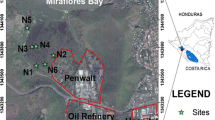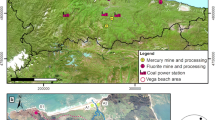Abstract
In order to characterize the mercury hazard in soil, a sequential extraction scheme has been developed to classify mercury species based on their environmental mobility and/or toxicity for either routine lab analysis or on-site screening purposes. The alkyl mercury species and soluble inorganic species that contribute to the major portion of potential mercury toxicity in the soil are extracted by an acidic ethanol solution (2% HCl+10% ethanol solution) from soil matrices as "mobile and toxic" species. A High-Performance Liquid Chromatography (HPLC) system coupled with Inductively Coupled Plasma Mass Spectrometry (ICP–MS) detection has been developed to further resolve the species information into soluble inorganic species (Hg2+), methylmercury(II) (MeHg+) and ethylmercury(II) (EtHg+) species. Alternatively, these species can be separated into "soluble inorganic mercury" and "alkyl mercury" sub-categories by Solid-Phase Extraction (SPE). A custom Sulfydryl Cotton Fiber (SCF) material is used as the solid phase medium. Optimization of the SCF SPE technique is discussed. Combined with a direct mercury analyzer (DMA-80), the SCF SPE technique is a promising candidate for on-site screening purposes. Following the ethanol extraction, the inorganic mercury species remaining in soil are further divided into "semi-mobile" and "non-mobile" sub-categories by sequential acid extractions. The "semi-mobile" mercury species include mainly elemental mercury (Hg) and mercury-metal amalgams. The non-mobile mercury species mainly include mercuric sulfide (HgS) and mercurous chloride (Hg2Cl2).




Similar content being viewed by others
References
Bloom NS, Porcella DB (1994) Nature 357:695
Bloom NS, Gill GA, Cappellino S, Dobbs C, Mcshea L, Driscoll C, Mason R, Rudd J (1999) Environ Sci Technol 33:7–13
Westöö G (1966) Anal Scand 20:2131
Padberg S, Burow M, Stoeppler M (1993) Fresenius J Anal Chem 346:686–688
Bulska E, Baxter DC, Frech W (1991) Anal Chim Acta 12:545–554
Horvat M, Byrne AR, May K (1990) Talanta 37:207–212
Alli A, Jaffe R, Jones R (1994) J High Resol Chromatogr 17:745–748
Lansens P, Baeyens W (1990) Anal Chim Acta 228:93–99
Filippelli M (1987) Anal Chem 59:116–118
Jiang G, Ni Z, Wang S, Han H (1989) Fresenius J Anal Chem 334:27–30
Hempel M, Hintelmann H, Wilken RD (1992) Analyst 117:669–672
Beauchemin D, Siu KWM, Berman SS (1988) Anal Chem 60:2587–2590
Horvat M, Bloom NS, Liang L (1993) Anal Chim Acta 281:135–152
Rezende MCR, Campos RC, Curtius AJ (1993) J Anal At Spectrom 8:247–251
Bloom NS (1989) Can J Fish Aquat Sci 46:1131–1140
Cai Y, Jaffe R, Alli A, Jones RD (1996) Anal Chim Acta 334:251–259
Bloom N Fitzgerald WF (1988) Anal Chim Acta 208:151–161
Horvat M, Liang L, Bloom NS (1993) Anal Chim Acta 282:153–168
Jian W, McLeod CW (1992) Talanta 39:1537–1542
Liang L, Horvat, M, Bloom NS (1994) Talanta 41:371–379
Emteborg H, Baxter DC, Sharp M, Frech W (1995) Analyst 120:69–77
Lansens P, Meuleman C, Leermakers M, Baeyens W (1990) Anal Chim Acta 234:417–424
Carro Diaz AM, Lorenzo-Ferreira RA, Cela-Torrijos R (1994) J Chromatogr A 683:245–252
Bushee DS (1988) Analyst 113:1167–1170
Bloxham MJ, Gachanja A, Hill SJ, Worsfold PJ (1996) J Anal At Spectrom 11:145–148
Huang CW, Jiang SJ (1993) J Anal At Spectrom 8:681–686
Boylan HM, Ronning TA, DeGroot RL, Kingston HM (2000) Environ Test Anal 9:8–13
USEPA (2000) Method 7473, Mercury in solids and solutions by thermal decomposition, amalgamation, and atomic absorption spectrophotometry, Test methods for evaluating solid waste, physical/chemical methods SW 846, Update IVA. US Government Printing Office (GPO), Washington, DC
Feldman C (1974) Anal Chem 46:99–102
Liu D, Liu R, Cui H (1992) Fenxi-Shiyanshi 11:32–34
Wilken RD, Hintelmann H (1991) Water Air Soil Pollut 56:427–437
Sanchez-Uria JE, Sanz-Medel A (1998) Talanta 47:509–524
Lee YH, Mowrer J (1989) Anal Chim Acta 221:259–268
Yu G, Pang S (1984) Kexue-Tongbao 10:1338–1342
Wang D, Liu S, Zhao L (1984) Fenxi-Huaxue 12:241–246
Wang Z, Cui X (1990) Chin J Oceanol Limnol 8:37–45
Dwyer FP, Mellor DP (1964) Chelating agents and metal chelates. Academic Press, New York
King RB (1994) Encyclopedia of inorganic chemistry. Wiley, Chichester, UK
USEPA (2000) Method 3052, Microwave assisted acid digestion of siliceous and organically based matrices, Test methods for evaluating solid waste, physical/chemical methods SW 846. US Government Printing Office (GPO), Washington, DC
Davis A, Bloom NS, Que-Hee SS (1997) Risk Anal 17:557–569
Revis NW, Osborne TR, Sedgley D, King A (1989) Analyst 114:823–825
Revis NW, Osborne TR, Holdsworth G, Hadden C (1989) Water Air Soil Pollut 35:105–113
Eganhouse RP, Young DR, Johnson JN (1978) Environ Sci Technol 12:1151–1157
Harsh JB, Doner HEJ (1981) Environ Qual 10:333–337
USEPA (2001) Draft method 3200, Mercury species by selective solvent extraction and acid digestion. US Government Printing Office (GPO), Washington, DC
Kingston HM (1995) US Patent 5 414 259
USEPA (2000) Method 6800, Elemental and speciated isotope dilution mass spectrometry, Test methods for evaluating solid waste, physical/chemical methods SW 846, Update IVA. US Government Printing Office (GPO), Washington, DC
Acknowledgement
The authors thank RCRA, USEPA, SAIC and Allegheny Power Inc. for funding and financial support, as well as Milestone Inc., Agilent Technologies and Duquesne University for instrument and material support.
The authors would like to dedicate this paper to Mr Oliver Fordham who has been an inspiration to the environmental methods development community over the past decade. Mr Fordham after initiating this work passed away this past year and will be missed by all whom he so selflessly served.
Author information
Authors and Affiliations
Corresponding author
Rights and permissions
About this article
Cite this article
Han, Y., Kingston, H.M., Boylan, H.M. et al. Speciation of mercury in soil and sediment by selective solvent and acid extraction. Anal Bioanal Chem 375, 428–436 (2003). https://doi.org/10.1007/s00216-002-1701-4
Received:
Revised:
Accepted:
Published:
Issue Date:
DOI: https://doi.org/10.1007/s00216-002-1701-4




